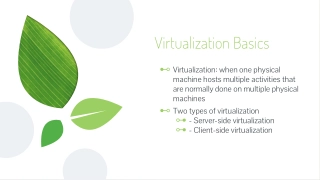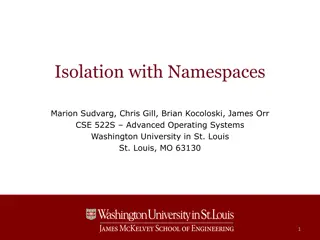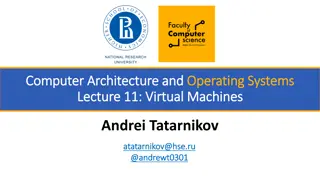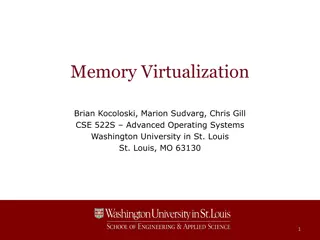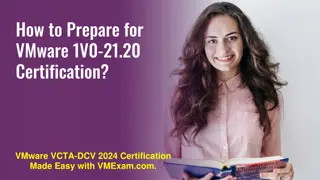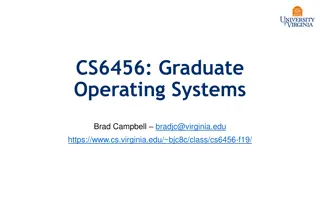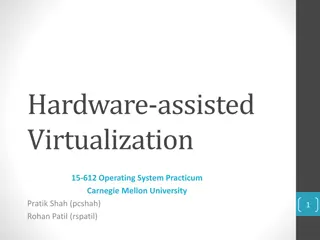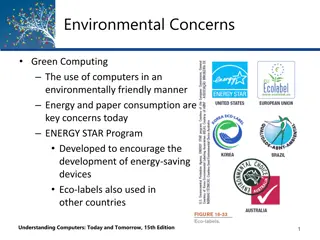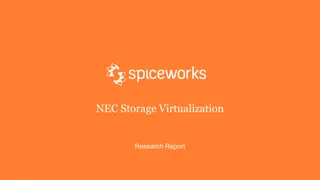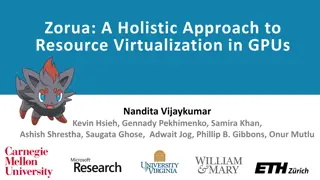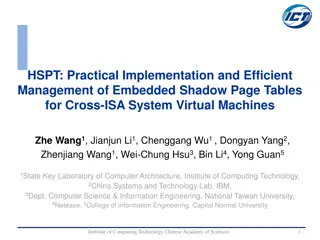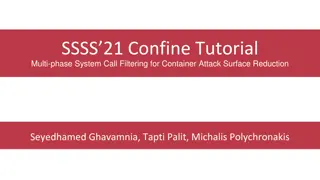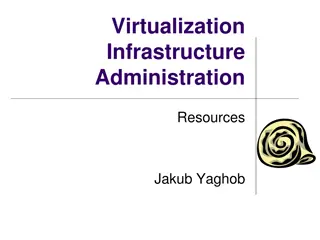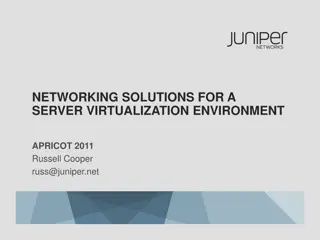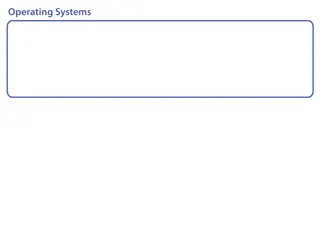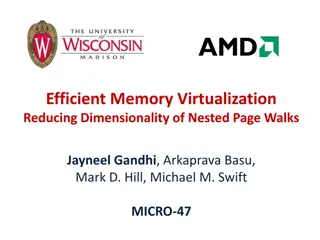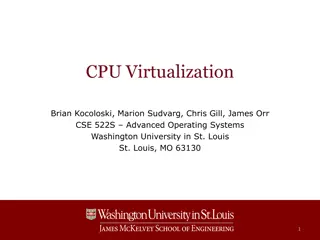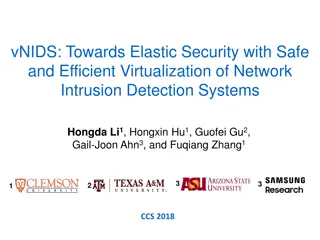Understanding Virtualization in Modern Systems
Virtualization plays a crucial role in modern systems by improving portability, security, and efficient resource utilization. Historical uses, examples like IBM VM/370, and benefits in cloud environments are discussed. The working of virtualization, including naive software interpreters and protected mode in x86 CPUs, is explained. Ensuring fast virtualization is essential for effective cloud operations.
Download Presentation

Please find below an Image/Link to download the presentation.
The content on the website is provided AS IS for your information and personal use only. It may not be sold, licensed, or shared on other websites without obtaining consent from the author. Download presentation by click this link. If you encounter any issues during the download, it is possible that the publisher has removed the file from their server.
E N D
Presentation Transcript
CS295: Modern Systems Virtualization Sang-Woo Jun Spring 2019
Historical Uses of Virtualization Application virtualization o Improves portability by running on virtual environment o JVM, .net, System virtualization (topic for today) o Emulates full system hardware in software to create one or more virtual machine instances on a single hardware instance o Security/isolation, manageability, OS development, efficient use of resources (important topic!) o IBM VM/370, vmware, qemu, Linux KVM,
IBM VM/370 Example Zhiming Shen, Virtualization Technology, CS 6410: Advanced Systems Fall 2016, Cornell University
Virtualization in the Cloud Virtualization is a fundamental piece of elastic clouds Reduces resource fragmentation, helps load balancing o For example, in a 8-core physical machine, four 2-core virtual machines can be spawned to efficiently use its resources o Without virtual machines, clouds will have to extremely accurately predict customer use cases, or suffer resource waste due to fragmentation o Reduce resource fragmentation, enabling efficient resource utilization for elastic resource allocation Economy of scale that makes clouds viable Conveniently spawn and kill instances We will now focus only on system virtualization But first and foremost, virtualization should be fast. Otherwise, it s pointless for the cloud
How Does Virtualization Work? The Na ve Way Write a software interpreter o A piece of software completely implements the CPU ISA and surrounding hardware o e.g., Bochs system emulator Pros: o Completely isolated, user-space implementation o Can emulate guest systems unrelated to host o Bochs is very useful for operating system development Cons: Very very slow! o Typically 100x slower Bochs logo
Before We Go On Protected Mode Recap Modern x86 CPUs have real mode and protected mode o On boot, BIOS/UEFI loads bootloader from storage into memory, and CPU starts executing it in real mode o Real mode has 1 MB addressable memory, no virtual memory or memory protection o The bootloader loads the kernel and executes it, which populates the virtual memory data structures for the CPU, among other bookkeeping, and switches forever into protected mode by setting a control register o From here, all memory accesses are through virtual memory (via TLB and virtual memory table)
Before We Go On Protection Rings Recap Modern CPUs assign different levels of access per process/thread o A process s ring determines which subset of instructions it can execute o Lower levels are more privileged, can execute all instructions that upper rings can o x86 CPUs have four rings, but most OSs use only two (0 : Supervisor mode , and 3 : User mode ) Privileged Instructions can only execute while in ring 0 (Kernel) o Managing virtual memory mappings, modify control registers, etc o Attempting one in user mode results in general protection fault exception GPF can be for many other reasons as well Source: Wikipedia
Before We Go On Exceptions Recap OS must supply the CPU with exception handlers o On x86, a table ( Interrupt Descriptor Table ) of pointers to each handler o On an exception (e.g., GPF), execution jumps to corresponding handler with information about where it happened o Handler runs in ring 0, and can do what it wants to handle or not handle the exception
Back To Virtualization Native Execution If virtual and host ISA is identical, most instructions can be run as-is Virtual Machine Manager creates a virtual system environment, (memory, display, etc) in userspace, and tries to execute OS code as if it is user software o Privileged instruction attempts are caught via exceptions, and handled by VMM to emulate what should have happened o The VMM must have kernelspace access! Typically what is called Hypervisor Pros: Very high performance Almost no overhead for computation- bound applications
Some Issues With Native Execution Some privileged instructions don t generate exceptions in user mode o popf (Pop flags) fails silently Guest virtual memory is cumbersome o Another layer of translation: Guest virtual memory -> Guest physical memory (host virtual memory) via virtual page table -> Host physical memory via physical page table
Binary Translation Typically used as performance optimization for cross-platform virtualization All software that is to run on a VM is translated during load to work better with the VM o Translated software (even OSs) can run just like normal software o Software for different ISA is translated to host ISA o Example: JVM JIT Special instructions are changed to point to handlers in VM o Interrupts, privileged instructions, etc now call handlers Solves the silent failure problem for native execution o Jump targets are overwritten
Binary Translation Issue: Indirect jumps o Jump targets depending on runtime variable is difficult to predict o Re-translating every time has a high performance overhead o We could create an index of the addresses of all original instructions and their translations Intractable overhead! o Typically a balance of the two o Not an issue with native execution Issue: Self-modifying code o Sometimes need to check for modifications and fall back to software interpreter
Shadow Page Table In a naively virtualized system, there are two page tables for the same guest memory access o Page table in the virtual CPU, pointing to virtual physical memory (host virtual memory) o Page table in the host CPU, pointing to host physical memory o During virtual virtual memory access, virtual CPU needs to do translation, harming performance For performance, a VMM can store guest memory mappings directly in host page table (guest virtual memory to host physical memory) o Guest MMU does no translation, and simply depends on host MMU to do the right thing
Shadow Page Table Guest OS can write to guest page table, but it doesn t do anything yet When guest tries to access that memory, page fault happens o Virtual CPU doesn t consult its page table, but directly forwards request to host CPU, causing a page fault caught by VMM o VMM reads guest page table (shadow page table) and updates its page table accordingly o Subsequent accesses function correctly Zhiming Shen, Virtualization Technology, CS 6410: Advanced Systems Fall 2016, Cornell University
The Modern Way Hardware-Assisted Virtualization Newer CPUs have hardware support for virtualization, which renders many of the above unnecessary o Intel VT-x, AMD-V Introduces the concept of ring -1, and a few more instructions o Hypervisor boots into ring -1, and uses ring -1 instruction (VMLAUNCH, etc) to spawn/manage/terminate VMs o VMs start in ring 0, thinking it has full control of CPU Interrupts are delivered to hypervisor for it to manage o Timer interrupts, etc used to bring execution back to hypervisor
The Modern Way Hardware-Assisted Virtualization Virtual memory management also moved to ring -1 o Second Level Address Translation (SLAT), or nested paging o Intel Extended page table (EBT), AMD Stage-2 MMU Now virtual memory translation can be nested in hardware o Hardware performs the translation from the guest physical address to host virtual address o Separate hardware registers for specifying guest and VMM VM location
Virtualizing Peripherals Network, storage, etc, Typically a small selection of generic virtual devices are provided to the virtual machine o Only the hypervisor knows of the actual hardware o Hypervisor performs scheduling as it sees fit When raw access must be given to a guest, the access is exclusive o Class of devices a generic catalog was not provided for o hypervisor acts as a raw bridge Some modern peripherals come with their own virtualization support o Per-VM queues and contexts
Paravirtualization Guest OS is modified to communicate with the hypervisor o Guest OS sees physical memory, and must work with hypervisor to cooperatively manage memory o Privileged instructions are changed to requests to hypervisor (hypercalls) Can greatly simplify hypervisor, improve performance


